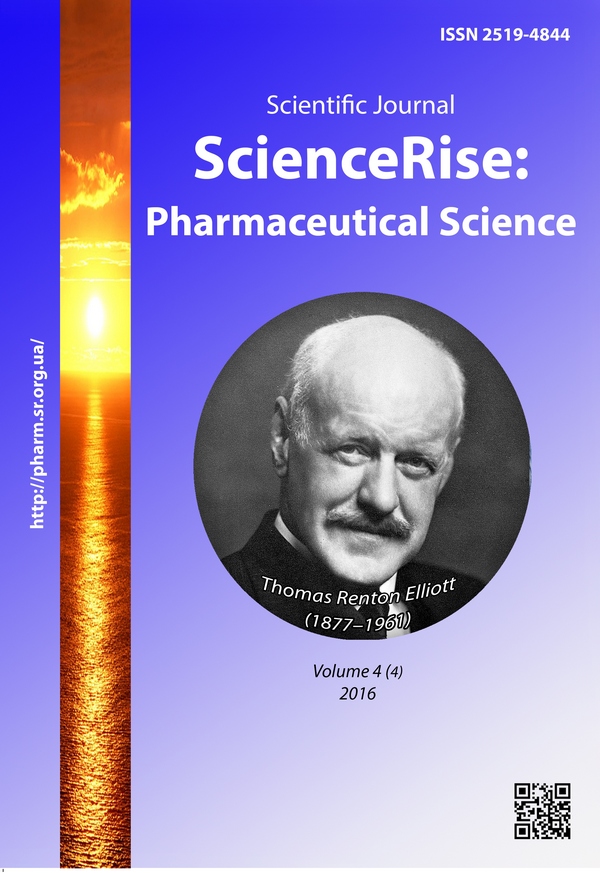Development of the method for qualitative analysis of shepherd’s purse herb to be included into the state pharmacopoea of ukraine draft national monograph
DOI:
https://doi.org/10.15587/2519-4852.2016.86172Keywords:
the State Pharmacopoeia of Ukraine, Shepherd’s purse herb, flavonoids, hydroxycinnamic acids, amino acidsAbstract
Shepherd’s purse herb is described in the State Pharmacopoeia of the USSR XI edition, the British Pharmacopoeia (BHP, 1996 «Shepherd´s Purse»), French Pharmacopoeia (Pharmacopee Francaise, 1998 «Bourse A Pasteur»), and German Pharmaceutical Codex (DAC Monograph 2004 «Hirtentäschelkraut»). Previously, it was reported that the modern methods for identification of biologically active compounds of Shepherd’s purse herb were absent in the State Pharmacopoeia of the USSR XI edition, but identification was carried out by external and microscopic diagnostic features.
Aim. Development of methods, harmonized with the SPhU requirements to herbal material, for identification of Shepherd’s purse herb using TLC method, for implementation to the Draft national Monograph “Shepherd’s purse herb”.
Methods. To achieve the mentioned goal, standardized methods of analysis of phenol compounds and amino acids by TLC method, described in the State Pharmacopoeia of Ukraine monographs, were used.
Results. Concerning chemical composition, medicinal use, and approaches to standardization, the following classes of compounds were selected for TLC identification: flavonoids, hydroxycinnamic acids, and amino acids. Development of the methods was carried out together with their validation according to the SPhU general article requirements.
Conclusion. Premise for “Identification” partition development for implementation to the SPhU Monograph “Shepherd’s purse herb” was substantiated. TLC methods for identification of flavonoids together with both hydroxycinnamic acids and amino acids, were developed. The analysis of different samples of Shepherd’s purse herb was carried out under the developed methods conditions. The possibility of including of “Identification C” flavonoids identification and “Identification D” amino acids identification into the Draft national Monograph “Shepherd’s purse herb” using TLC by the developed methods was confirmed
References
- Kolisnyk, Yu. S. (2016). Farmakohnostychne doslidzhennya Capsella bursa-pastoris (L.) Medik [Pharmacognostic study of Capsella bursa-pastoris (L.) Medik]. Kharkiv, 23.
- Larina, S. Yu., Saulich, M. I. (2008). Areal i zona vredonosnosti pastushey sumki Capsella bursa-pastoris (L.) Medik. (Semeystvo Kapustnyie Brassicaceae Burnett (Cruciferae Juss.), rod Pastushya sumka Capsella Medik. Vestnik zaschityi rasteniy, 1, 46–47.
- Al-Khalil, S. (2000). Chemical constituents of Capsella bursa-pastoris. Alexandria Journal of Pharmaceutical Sciences, 14 (2), 91–94.
- Assessment report on Capsella bursa-pastoris (L.) Medikus, herba (2010). European Medicines Agency, 20. Available at: http://www.ema.europa.eu/docs/en_GB/document_library/Herbal_-_HMPC_assessment_report/2011/01/WC500100944.pdf
- Song, N., Xu, W., Guan, H., Liu, X., Wang, Y., Nie, X. (2007). Several flavonoids from Capsella bursa-pastoris (L.) Medik. Asian Journal of Traditional Medicines, 2 (6), 218–222.
- Bekker, N. P., Ul'chenko, N. T., Hlushchenkova, A. Y. (2002). Lipidyi vozdushnoy chasti Capsella bursa-pastoris. Chemistry of natural compounds, 38 (6), 610–611.
- Hasan, N. R., Ali, M. R., Shakier, S. M., Khudhair, A. M., Hussinet, M. S., Kadum, Y. A., Mohammed, A. I. et. al. (2013). Antibacterial Activity of Aqueous and Alcoholic Extracts of Capsella Bursa against Selected Pathogenic Bacteria. American Journal of BioScience, 1 (1), 6–10. doi: 10.11648/j.ajbio.20130101.12
- Alizadeh, H., Jafari, B., Babae, T. (2012). The study of antimicrobial effect of Capsella bursa-pastoris on some of gram positive and gram negative bacteria. Journal of Basic and Applied Sciences, 2 (7), 6940–6946.
- Stepanova, E. F., Vasilenko, Yu. K., Frolova, L. M. (1992). Ispolzovanie vyisushennyih izvlecheniy iz travyi pastushey sumki v kachestve gepatozaschitnyih sredstv. Pharmacy, 43 (2), 9–10.
- Derzhavnyy reyestr likars'kykh zasobiv Ukrayiny. Mіnіsterstvo ohoroni zdorov'ja Ukraini. Available at: www.drlz.com.ua
- Arzamastseva, A. P., Samyilinoy, I. A. (Eds.) (2002). Lekarstvennyie rastitelnyie sredstva sprav. Moscow: GEOTAR MED, 288.
- British Herbal Pharmacopea (1996). British Herbal Medicine Association, 169–170.
- Deutscher arzneimittel codex. Available at: http://dacnrf.pharmazeutische-zeitung.de/index.php?id=26
- Pharmacopee Francaise. Available at: www.http://ansm.sante.fr/Mediatheque/Publications/Pharmacopee-francaise-Plan-Preambule-index
- Gosudarstvennaya farmakopeya SSSR. Obschin metodyi analiza. Lekarstvennoe rastitelnoe syire (1990). Moscow: Medicine, 308–309.
- Kotov, A. H. (2011). Pravyla vykladannya ta poryadok rozrobky monohrafiy na likars'ku roslynnu syrovynu. Upravlinnya, ekonomika ta zabezpechennya yakosti v farmatsiyi, 6 (20), 16–22.
- Kotov, A. H. (2012). Pravyla vykladannya ta poryadok rozrobky monohrafiy na likars'ku roslynnu syrovynu. Upravlinnya, ekonomika ta zabezpechennya yakosti v farmatsiyi, 1 (21), 4–10.
- Grizodub, A. I., Georgievskiy, G. V., Tihonenko, T. M. Georgievskiy, V. P. (2004). Problemyi vvedeniya monografiy na lekarstvennoe rastitelnoe syire v Gosudarstvennuyu Farmakopeyu Ukrainyi. Farmakom, 4, 3–17.
- Kyslychenko, V. S., Kuznyetsova, V. Yu., Kolisnyk, Yu. S. (2014). Pro neobkhidnist' rozrobky monohrafiyi «Hrytsykiv trava» dlya vvedennya do Derzhavnoyi farmakopeyi Ukrayiny. Zbirnyk naukovykh prats' spivrobitnykiv NMAPO imeni P. L. Shupika, 23 (4), 281–287.
- Derzhavna Farmakopeya Ukrayiny. Vol. 1 (2015). Kharkiv: Derzhavne pidpryyemstvo “Naukovo-ekspertnyy farmakopeynyy tsentr”, 83.
- Kotova, E. E., Kotov, A. H. (2015). Systematyzatsiya farmakopeynykh vymoh do metodiv kontrolyu yakosti likars'koyi roslynnoyi syrovyny. Unifikovani TShKh metodyky. Farmakom, 1, 41–47.
Downloads
Published
How to Cite
Issue
Section
License
Copyright (c) 2016 Вікторія Юріївна Кузнєцова, Вікторія Сергіївна Кисличенко, Еліна Едуардівна Котова, Андрій Георгієвич Котов, Наталя Анатоліївна Сущук

This work is licensed under a Creative Commons Attribution 4.0 International License.
Our journal abides by the Creative Commons CC BY copyright rights and permissions for open access journals.








